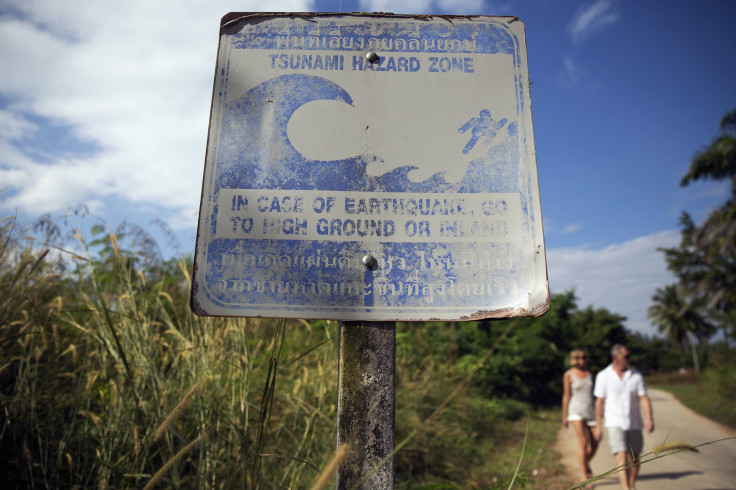2004 Indian Ocean Tsunami 10 Years Later: Warning System Installed After Disaster Has 'Critical Gaps'

The devastating Indian Ocean tsunami of 2004 struck more than a dozen countries, but up to that moment there was a glaring lack of tsunami warning systems in the region, despite the frequency of earthquakes there. Ten years later, a tsunami-detecting system has been set in place, but the United Nations says “critical gaps remain,” and there are many remote communities that still fall through the safety net. While the system can send out warnings quickly, dissemination of the alerts to people on the ground takes time, giving those closest to earthquake epicenters only minutes to escape.
The technology provisions are in place, but it "is important to continue to invest in early warning systems,” said Sanjay Kumar Srivastava, regional adviser for the United Nations Economic and Social Commission for Asia and the Pacific. “In particular, investments are needed at the local level to maintain and further increase preparedness and to make sure that local communities are properly linked to the warning system.”
Prior to 2004, what passed for a tsunami and earthquake warning system in the Indian Ocean region was intuition. “It was based on people feeling the earthquake and then running,” said Walter Mooney, research seismologist at the U.S. Geological Survey.
The day after Christmas 2004, a 9.1-magnitude undersea earthquake erupted off the west coast of Sumatra, Indonesia. The resulting tsunami, with waves up to 100 feet high, devastated countries throughout the Indian Ocean, making it one of nature’s deadliest disasters on record. More than 230,000 people in 14 countries died.
At the time, few countries had plans in the event of tsunamis. “We were sent to Sri Lanka for a convention to discuss disasters, and tsunamis were not even on the program,” Mooney said. Governments and agencies believed more predictable disasters such as storms deserved more attention, due to time and resource constraints, Mooney said. “We were completely wrong,” Mooney said, noting that the 2004 tsunami caught everyone by surprise.
The most comprehensive tsunami-detecting system then existed in the Pacific Ocean, where frequent-enough tsunamis in what is called the Ring of Fire region justified its installation. However, the western edge of the Ring of Fire extends into the Indian Ocean, where monitoring was lacking. “Even though we recognize a need for such systems there, it might be hundreds of years for an occurrence of a big tsunami there,” said Mike Angove, tsunami program manager of the U.S. National Oceanic and Atmospheric Administration (NOAA), which maintains the Pacific monitoring system.
After the powerful underwater earthquake, the UNESCO Intergovernmental Oceanographic Commission created the Indian Ocean Tsunami Warning System to create “tsunami resilient” communities in the region. The warning system works in two parts: A network of underwater pressure sensors called DART (Deep-ocean Assessment and Reporting of Tsunamis), upon sensing a drastic pressure change, sends an alert to ground centers. That information is then relayed to areas about to be hit by a tsunami.
The system was conceived in 2005 and was fully functional February 2008, a few months ahead of schedule, according to Mooney. However, an earthquake and tsunami in July 2006 hit Java, Indonesia, before the system was ready, resulting in 600 deaths. In 2012, another 8.4- magnitude earthquake shook Banda Aceh, on the island of Sumatra, and the warning system alerted the Andaman and Nicobar Islands of India within eight minutes, but took 20 to reach warning sirens in Aceh province because of electrical grid failure.
Such challenges have prompted debate about the effectiveness of these warning systems unless participant countries share data. “Data collected by Indonesia could be useful to India,” said Mooney. But, according to Laura Kong, director of the International Tsunami Information Center, few participant countries have been motivated to be more open with their data.
Another “critical gap” is that the warning system cannot reach communities that are close to earthquake epicenters in time, leaving residents just 10 to 20 minutes to respond. “Warning sensors can only do it so fast,” Kong said. “For such cases, you have to rely on education.”
Kong said tsunami education outreach, such as explaining the natural warning signs and knowing what to do, could improve the warning system. But outreach can be hard given linguistic diversity and lack of access to remote communities. Angove from the NOAA said education efforts have gotten creative. Some agencies, for example, rely on mosques in these areas as an outlet to spread awareness, but even that can present a challenge.
“If you’re in such a belief that natural disasters are a sign from God,” said Kong, “one might say, ‘Well, it doesn’t matter if I’m prepared and know what to do – it doesn’t matter,’ ” especially if potential victims believe God will protect them.
© Copyright IBTimes 2025. All rights reserved.




















